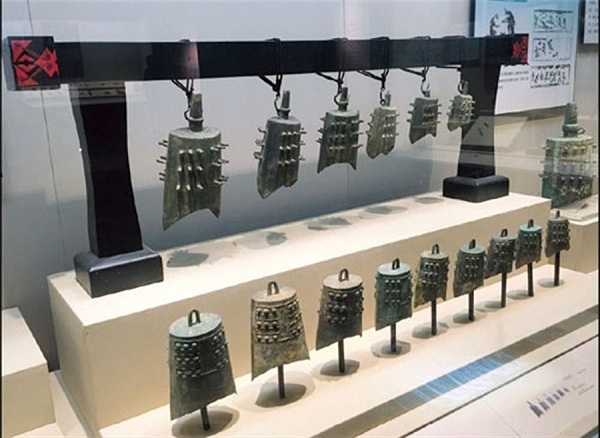
A bronze bianzhong, an ancient musical instrument that consists of a set of bronze bells, which was played for ritual music at the imperial court.(Photo/Shanghai Daily)
Present-day Zhejiang Province developed from the ancient Yue Kingdom and is said to date back thousands of years.
Today, Zhejiang is still defined by characteristics of the old Yue culture. Several antiques and relics sites have been discovered across the province, providing archeologists with clues of how the Yue people lived throughout the course of history.
Now, a permanent exhibition that displays the kingdom's long history is underway at Zhejiang Museum's Wulin Pavilion, giving visitors a chance to appreciate these rare artefacts.
The exhibition is split up into several sections, stretching from the primeval period to the Qing Dynasty (1644-1911).
The first part mainly showcases antiques from Neolithic Kuahu Bridge culture and Hemudu culture, which laid the foundation of the Yue. At first, the two sites were considered unrelated, but then archaeologists found that the Neolithic relic sites north of the Qiantang River had an impact on one another's development.
A canoe excavated from Kuahu Bridge that is considered the oldest found in the country is part of the exhibit.
Grains discovered at the two sites indicate that rice was harvested in the area 1,000 years earlier than previously believed.
When people along the Yellow River became increasingly sovereign during the Xia (c. 21st century-16th century BC), Shang (c.16th century-11th century BC) and Zhou (c. 11th century-221 BC) dynasties, the Yue people were considered savage, fierce ethnic minorities that ate raw meat and worshipped witchcraft.
The center of the original Yue Kingdom was today's Shaoxing City. Yue culture has its own music and dance. Stone, metal, bamboo, wood and porcelain were used to make instruments like the bianzhong, an ancient musical instrument that consists of a set of bronze bells, which was used was for ritual music played at the imperial court. The exhibition features a bronze and a porcelain bianzhong.
At the time, the Yue began an exchange with the Xu Kingdom (present-day northern Jiangsu Province and southern Shandong Province) since the latter was conquered during Spring and Autumn Period (770-476 BC). Inscriptions on bronze vessels recorded how the Xu people were defeated and fled.
The Yue began to spread in China and to other countries like Japan, the Philippines, Vietnam and Malaysia, where stone and bronze antiques believed to have been brought by migrant Yue people were found.


















































